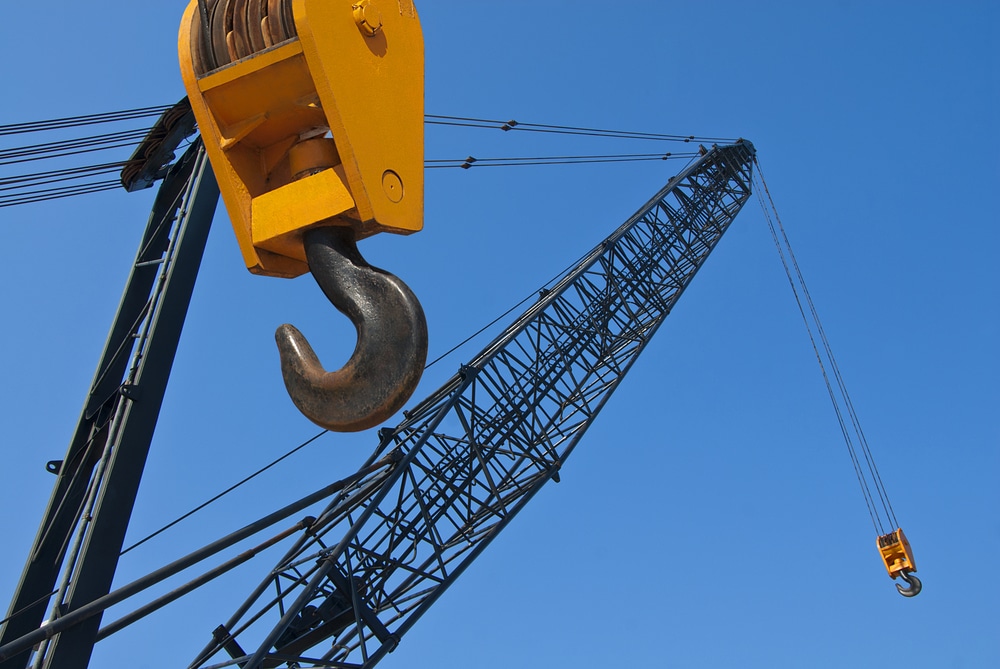
Cranes are one of the most common forms of equipment seen at various construction sites, allowing crews to lift and move huge volumes of materials that wouldn't be possible otherwise. If you're among any contractors or workers who will be working with or even alongside a crane during any part of your job, it's important to understand the basic parts and functions that make up a typical crane.
At Mountain Crane, we're proud to offer a variety of crane rental products, from crawlers and hydraulic all-terrain cranes to lattice truck cranes and several other options as well. What are the most basic components of a standard crane that you should be aware of? Here's a rundown.
One of the most well-known parts of a crane, and also one of its most important, is the hook. Crane hooks connect the crane itself to the load it's lifting, and without this important piece you'd have trouble transporting materials from place to place. This is typically more of a fixed component on the crane, although there are options that allow you to unhook a load once it has been lifted.
Crane hooks need to be strong and durable, with the ability to adjust to a variety of weights and maximize the overall efficiency of your crane. However, as we'll reveal in our next several sections, the hook is only able to function properly if certain other parts of the setup are also organized well.
To ensure heavy loads being lifted won't break their lines, wire rope is used to connect the crane hook to the load itself. In most cases, this is a flexible steel cable that's been twisted into the shape of a helix for ideal strength, but it isn't always an option for every job. Carrying wire rope in ¼ inch or ½ inch configurations, we have a variety of options that can help connect your material from one place to another safely and securely.
Sheaves refer to components that increase the weight a given hook is able to lift. Sheaves are made up of a pulley system that's used to guide the wire rope, and they come in a variety of sizes depending on your needs. The larger or smaller sheave you opt for, the less weight it will support; this means some options can easily lift heavy objects without worrying about additional components, but others with fewer parts will be perfect for lighter loads.
One of the single largest crane parts to be aware of is the boom, which is what you're likely familiar with seeing as you drive by a construction site. The boom serves as the "arm" that allows you to move heavy loads from one place to another, and it's typically shown in the form of a horizontal beam with an adjustable angle.
There are two boom types used for modern cranes:
Because cranes hold so much weight, counterweights are needed to stop them from tipping over. There are typically two types of counterweights used in cranes, and they can be adjusted to accommodate different needs:
Outriggers refer to parts that provide safety, extending from the bottom of the crane and helping stabilize the entire machine when reaching to elevated heights. Outriggers are only used when the crane itself goes beyond the reach of a vehicle's stabilization equipment, and they can be adjusted based on what you're lifting and where you're working.
Cranes also need to be able to move around a construction site, and they do so by way of wheels or tracks. Many cranes are also designed to elevate themselves for additional stability, which is crucial when working in elevated areas with heavy materials. Cranes that do this are called aerial forklifts or telescopic handlers, and they use wheeled drive systems to get around the site.
Tracked cranes generally move a bit slower than wheeled cranes, but do so more safely and in a more stable manner.
The hoist, also called a hoist drum, is the part of the crane that actually lifts the load. It's the cylindrical device at the top of the crane, and it can rotate around a horizontal or vertical axis depending on how you need to move your material.
Finally, for situations where cranes need to move materials to any area that's beyond the boom's natural reach, the jib is used. This is an arm-like part of the crane that extends out horizontally, and it can be elevated or lowered to reach different heights. Jibs come in a few different variations, including spreader jibs and hammerhead jibs.
For more on the important components of a crane that you should be aware of before renting or operating one, or to learn about any of our crane rental or wind energy transport services, speak to the staff at Mountain Crane today.

Mountain Crane offers one of the largest fleet of cranes in the Mountain West! Our diverse fleet has the right crane for your job!